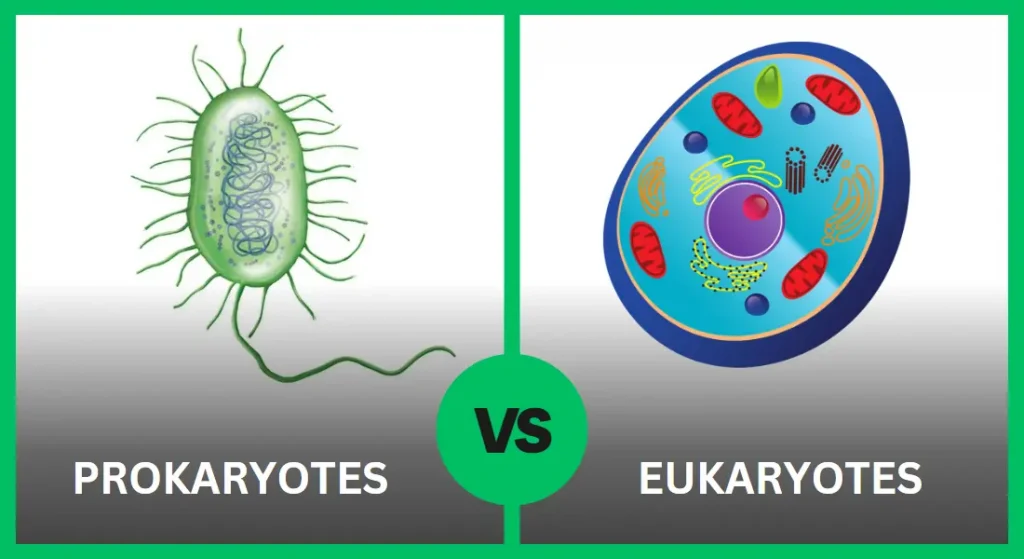Unveil the mystery behind the microbial world with our ultimate guide on Prokaryotes vs Eukaryotes. Explore the key differences between these two kingdoms and expand your knowledge today!
In this article, we will provide a comprehensive overview of the differences and similarities between prokaryotic and eukaryotic cells. We will cover 27 key differences and similarities, ranging from cell structure and size to genetic material and reproduction.

Prokaryotes vs Eukaryotes: Overview
Before we discuss the distinctions and similarities between prokaryotes and eukaryotes, let’s briefly introduce these two types of cells.
Prokaryotes are single-celled organisms without nuclei or other membrane-bound organelles. They are typically smaller and have a simpler structure than eukaryotic cells. Prokaryotes include bacteria and archaea as examples.
In contrast, eukaryotes are organisms that have cells with a nucleus and other membrane-bound organelles. They are larger and more complicated in structure than prokaryotic cells. Eukaryotes include animals, plants, fungi, and protists as examples.
Now, let’s move on to the differences and similarities between these two types of cells.
Key Differences between Prokaryotes and Eukaryotes
Cell Structure and Size
- Typically, prokaryotic cells are smaller than eukaryotic cells. Prokaryotic cells usually have a size of 0.1 to 5 micrometres, whereas eukaryotic cells have a size of 10 to 100 micrometres.
- Eukaryotic cells contain a distinct nucleus, whereas prokaryotic cells do not.
- Eukaryotic cells have membrane-bound organelles such as the Golgi apparatus, endoplasmic reticulum, and mitochondria, but prokaryotic cells do not.
- Eukaryotic cells have a cell membrane and a cell wall consisting of cellulose or chitin, whereas prokaryotic cells have a cell wall made of peptidoglycan.
- Eukaryotic cells have linear DNA structured into chromosomes, whereas prokaryotic cells contain circular DNA that is not.
- Eukaryotic cells contain cilia, flagella, or pseudopodia for movement, whereas prokaryotic cells have pili and flagella.
- Eukaryotic cells go through mitosis or meiosis, while prokaryotic cells divide by binary fission.
Metabolism and Energy Production
- Prokaryotic cells have a simpler metabolism, while eukaryotic cells have a more complex metabolism.
- Prokaryotic cells can perform anaerobic respiration, while eukaryotic cells can perform both anaerobic and aerobic respiration.
- Prokaryotic cells can fix nitrogen, while eukaryotic cells cannot.
Genetic Material
- Eukaryotic cells have numerous linear chromosomes, but prokaryotic cells only have one circular chromosome.
- Eukaryotic cells go through meiosis; prokaryotic cells do not.
- Eukaryotic cells lack plasmids and small, circular DNA fragments that can be transferred between cells but are present in prokaryotic cells.
- Eukaryotic cells can have a haploid or diploid genome, whereas prokaryotic cells have a haploid genome.
Gene Expression and Regulation
- Prokaryotic cells have a simpler gene expression and control system than eukaryotic cells.
- Operons are clusters of genes that are transcribed and controlled as a single unit in prokaryotic cells but not in eukaryotic cells.
- Prokaryotic cells have a simpler mechanism for post-transcriptional modification than eukaryotic cells.
Protein Synthesis
- Prokaryotic cells have a simpler protein synthesis mechanism than eukaryotic cells.
- Prokaryotic cells have ribosomes that are smaller in size than eukaryotic ribosomes.
- Prokaryotic cells do not have a 5′ cap or a poly(A) tail on their mRNA, while eukaryotic cells do.
Cell Division
- Prokaryotic cells divide by binary fission, while eukaryotic cells divide by mitosis or meiosis.
- Prokaryotic cells do not have a mitotic spindle, while eukaryotic cells do.
Reproduction
- Prokaryotic cells reproduce asexually, while eukaryotic cells reproduce sexually or asexually.
- Prokaryotic cells can exchange genetic material through conjugation, transformation, or transduction, while eukaryotic cells do not.
Evolutionary History
- Prokaryotic cells are believed to have evolved before eukaryotic cells.
- The endosymbiotic theory proposes that mitochondria and chloroplasts were once free-living prokaryotic cells that were engulfed by eukaryotic cells and eventually formed a symbiotic relationship with them. This theory is supported by several pieces of evidence, including that mitochondria and chloroplasts have their own DNA, reproduce independently of the host cell, and are similar in size and shape to certain types of bacteria.
Key Similarities between Prokaryotes and Eukaryotes
While there are many differences between prokaryotic and eukaryotic cells, they also share some key similarities.
Genetic Material
DNA is the genetic material found in both prokaryotic and eukaryotic cells. While the organization of DNA varies between the two types of cells, the DNA’s basic chemical composition remains the same.
Cell Membrane
Both prokaryotic and eukaryotic cells contain cell membrane that separates the inside of the cell from the outside environment. This membrane comprises a lipid bilayer permeable to specific chemicals and helps regulate the cell’s internal environment.
Ribosomes
Ribosomes, which are responsible for protein synthesis, are found in both types of cells. Although the size and structure of ribosomes change between bacterial and eukaryotic cells, their function is the same.
Metabolism:
Both prokaryotes and eukaryotes have the ability to metabolize.
Reproduction:
Both prokaryotes and eukaryotes reproduce.
Adaptability:
Both prokaryotes and eukaryotes have the ability to adapt to their environment.
Evolution:
Both prokaryotes and eukaryotes are capable of evolving over time.
Features of eukaryotic cells not found in prokaryotes:
- Division of cells into nucleus and cytoplasm, separated by a nuclear envelope
containing complex pore structures - Complex chromosomes composed of DNA and associated proteins that are
capable of compacting into mitotic structures - Complex membranous cytoplasmic organelles (includes the endoplasmic reticulum, Golgi complex, lysosomes, endosomes, peroxisomes, and glyoxisomes)
- Specialized cytoplasmic organelles for aerobic respiration (mitochondria) and photosynthesis (chloroplasts)
- Complex cytoskeletal system (including actin filaments, intermediate filaments, and microtubules) and associated motor proteins
- Complex flagella and cilia
- Ability to ingest particulate material by enclosure within plasma membrane vesicles (phagocytosis)
- Cellulose‐containing cell walls (in plants)
- Cell division using a microtubule‐containing mitotic spindle that separates chromosomes
- Presence of two copies of genes per cell (diploidy), one from each parent
- Presence of three different RNA synthesizing enzymes (RNA polymerases)
- Sexual reproduction requiring meiosis and fertilization

ITS AN AMAZING NOTES I FEEL REALLY HELPFULL FROM THIS WEBSITE